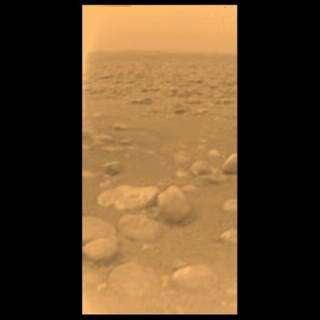Sounds From Titan And New Images
ESA presents audio data collected by the Huygens Atmospheric Structure Instrument (HASI), which includes an acoustic sensor, during Huygens' descent, 14 January 2005. A couple of more pictures have been revealed.
On 14 January 2005 the Huygens mission finally became a reality. The probe made its successful descent through the atmosphere of Titan and to a landing on the surface of this distant moon. Scientists have revealed the their initial findings based on analysis of the Huygens data.
1. Speeding through Titan's haze
This recording is a laboratory reconstruction of the sounds heard by Huygens' microphones. Several sound samples, taken at different times during the descent, are here combined together and give a realistic reproduction of what a traveller on board Huygens would have heard during one minute of the descent through Titan's atmosphere.
Listen: acoustic during descent
2. Radar echos from Titan's surface
This recording was produced by converting into audible sounds some of the radar echoes received by Huygens during the last few kilometres of its descent onto Titan. As the probe approaches the ground, both the pitch and intensity increase. Scientists will use intensity of the echoes to speculate about the nature of the surface.
Listen: radar conversion
More images:

This composite was produced from images returned by ESA's Huygens probe during its successful descent to land on Titan. It shows a full 360-degree view around Huygens. The left-hand side, behind Huygens, shows a boundary between light and dark areas. The white streaks seen near this boundary could be ground 'fog' of methane or ethane vapour, as they were not immediately visible from higher altitudes. As the probe descended, it drifted over a plateau (centre of image) and was heading towards its landing site in a dark area (right). This dark area is possibly a drainage channel which might still contain liquid material. From the drift of the probe, the wind speed has been estimated at around 6-7 metres per second. These images were taken from an altitude of about 8 kilometres with a resolution of about 20 metres per pixel. Credits: ESA/NASA/University of Arizona

This image was returned by ESA's Huygens probe during its successful descent to land on Titan. This is the coloured view, following processing to add reflection spectra data, gives a better indication of the actual colour of the surface. Initially thought to be rocks or ice blocks, they are more pebble-sized. The two rock-like objects just below the middle of the image are about 15 centimetres (left) and 4 centimetres (centre) across respectively, at a distance of about 85 centimetres from Huygens. The surface is darker than originally expected, consisting of a mixture of water and hydrocarbon ice. There is also evidence of erosion at the base of these objects, indicating possible fluvial activity. Credits: ESA/NASA/University of Arizona
Source: ESA, NASA















